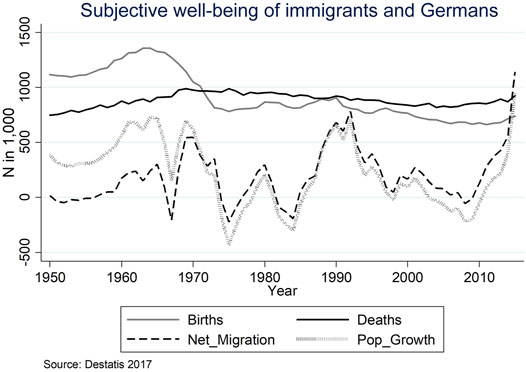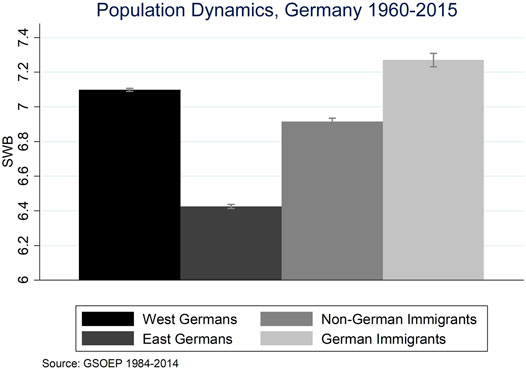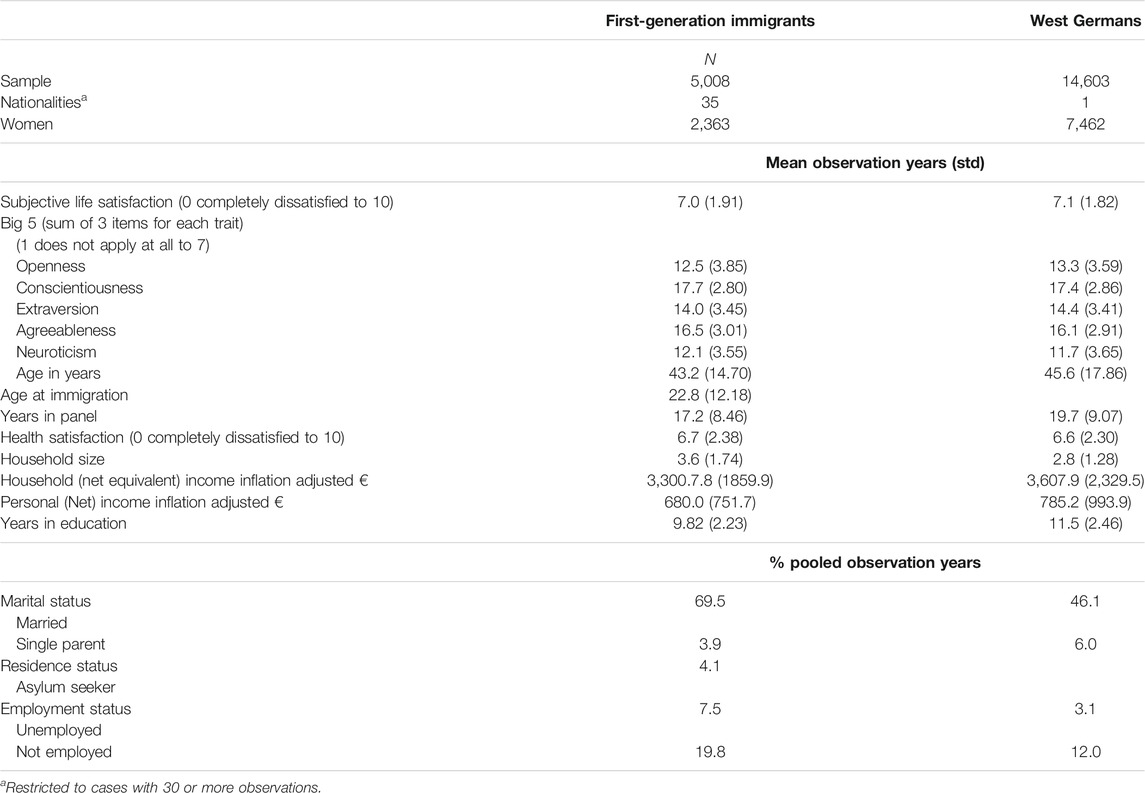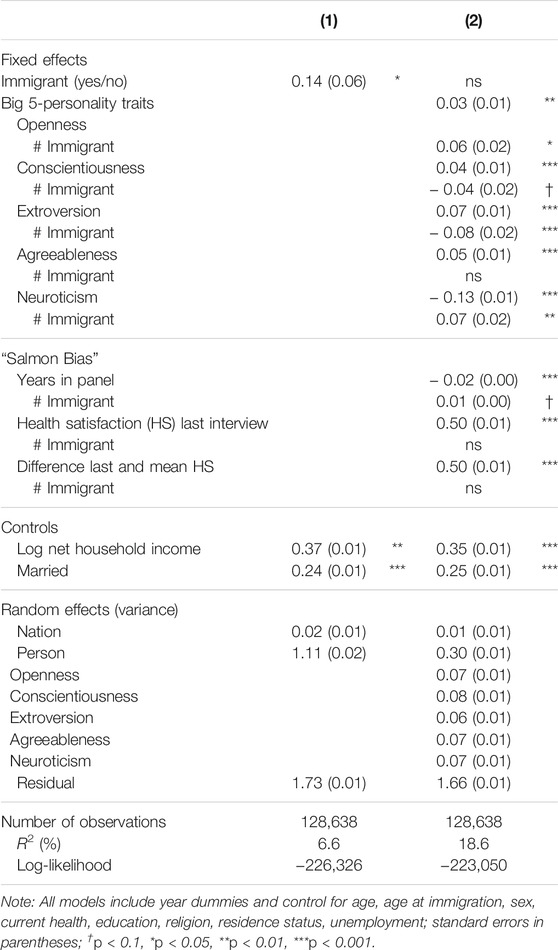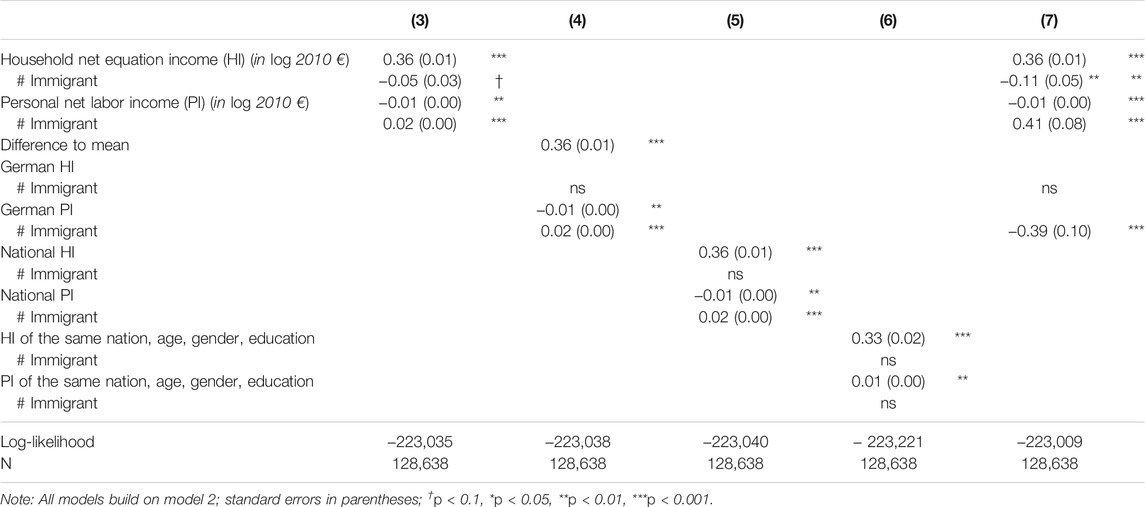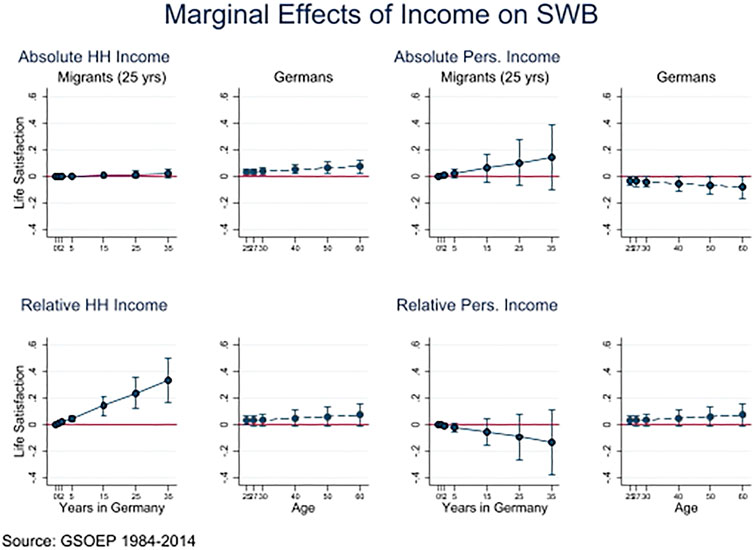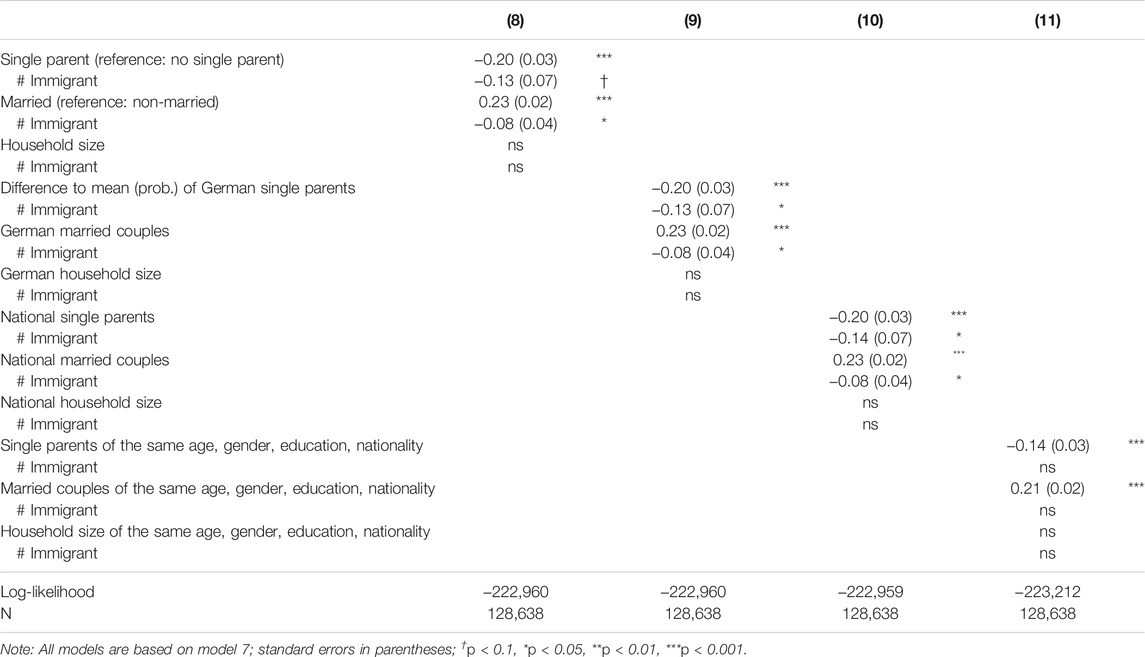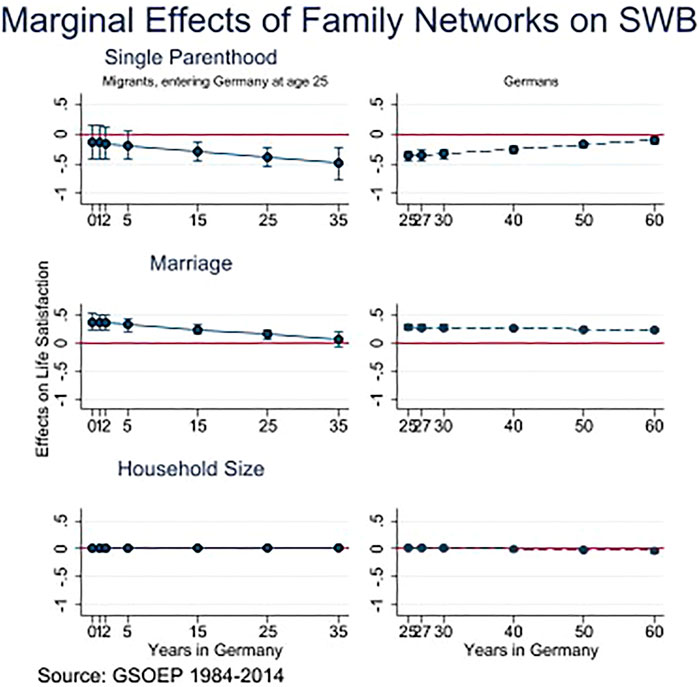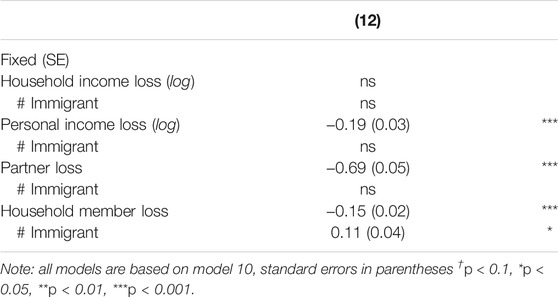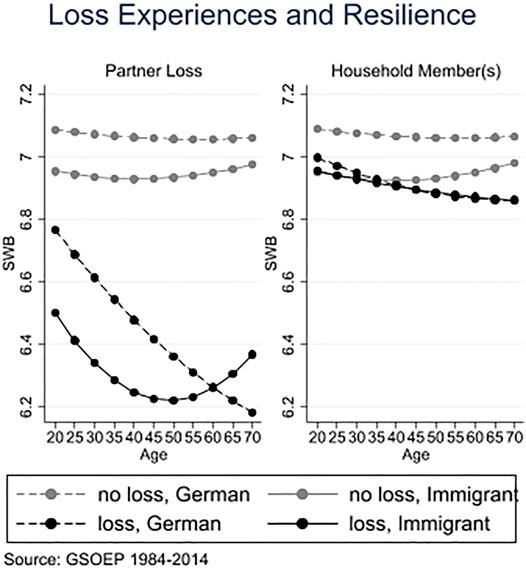- School of Humanities and Social Sciences, Jacobs University Bremen, Bremen, Germany
First-generation immigrants are surprisingly satisfied with their life compared to the local population in Germany. Is this because newcomers are particularly resourceful? We test if personality selectivity, purposive adaptation, and social resilience separately or in tandem explain why subjective well-being remains high even in times of objective disadvantage. Using German panel data (GSOEP) from 5,008 first-generation immigrants for the years 1984–2014 and official data, growth curve models show that newcomers are a selected group with respect to their open and less neurotic personalities and that these personal characteristics are distinctly associated with happiness. Also, newcomers immediately compare their income to the standards in the host society but not their family life. This contributes to boosting their subjective well-being as well. For more than 30 years, first-generation immigrants use their country of origin as a reference point thus protecting the positive association of intimate relationships and happiness. Finally, newcomers are highly capable of recovering from social loss. Since the resources used by first-generation migrants to preserve their subjective well-being are unlikely to be confined to Germany, our findings can inform policy-making. Most importantly, they suggest that the economic integration of newcomers should be fast and easy while family reunification and integration should follow only with a time lag.
Contribution to the Field
The article adds to the growing and important research on subjective well-being of first-generation international immigrants. It shows that the relationship need not be negative: migrants can actually be happier than the local population. Rich panel data and advanced statistical models allow disentangling pre- and post-migratory processes. The main innovation is to address personality selectivity and to identify two additional social mechanisms—purposeful adaptation and social resilience—that enable resourceful migrants to lead a satisfying and happy life after entering the host country. All mechanisms work together but with different dynamics. Policy-making should take note of the different clocks of adaptation and speed up economic integration relative to family reunification.
Introduction
In times of worldwide rising numbers of international migrants, this article asks if, when and why newcomers may be happier than the host population? Happiness is not a luxury good but as more and more research on subjective well-being (SWB) or happiness shows a universal goal and a proximate determinant of behavior. Happy migrants may also be perceived as a population resource and not as a societal burden as they assimilate successfully and stay longer in host countries (Shamsuddin and Katsaiti 2020). A first pooled snapshot of the subjective well-being of immigrants, aliens, and naturalized, as well as ethnic German re-settlers shows comparably high levels of happiness in Germany (Figure 1).
The data is based on a representative sample of panel data from 1984-2014 and includes 35 different nationalities. In this study, Germany, one of Europe’s largest non-traditional immigration countries, serves as a test case. Germany’s population is (comparably) rich and old, its fertility is one of the lowest in the world, and population growth depends on positive in-migration since decades (Figure 2). Migrants come in waves and with diverse ethnic backgrounds. In the future, all European and other advanced countries will likely follow this demographic pattern.
The article adds to the emerging literature on the subjective well-being of migrants (e.g., Angelini et al., 2015; Helliwell et al., 2018; Hendriks and Bartam 2019; Olgiati et al., 2013). In this literature, it is still far from clear to what extent and when the happiness of migrants depends on the same factors as the happiness of the local population. Given the persistent legal, economic, and social disadvantages immigrants face (Dancygier and Laitin 2014; Heizmann and Boehnke 2018; Leopold et al., 2017), most studies show much lower levels of subjective well-being among newcomers than among natives, particularly in Europe where in-migration is a historically new phenomenon and right-wing xenophobic movements are widespread (e.g., Bălţătescu 2007; Safi 2010; Kóczán 2016). Experimental evidence from Tonga and New Zealand also suggests that migration causes unhappiness (Stillman et al., 2015). On the other hand, better (mental) health and lower subjective expectations are factors that could boost the satisfaction and happiness of migrants despite objective discrimination (e.g., Erlinghagen 2011; Melzer, and Muffels 2017).
This article tests how three possible mechanisms affect the subjective well-being of migrants simultaneously and over a decade-long time horizon. The first explanation focuses on the (largely inherited) personality of first-generation immigrants. In contrast to natives, immigrants have been able and (often) willing to leave their former lives and countries behind. Perhaps as a result (voluntary), migrants have a personality that is on average better equipped for a happy life.
The second explanation considers international migration as a long-lasting process during which migrants make many choices. Being part of two cultures provides immigrants with options for choosing reference standards that the domestic population lacks. They may have an improved capacity to assess circumstances differently, and to compare downwards, hence increasing their happiness.
The third explanation refers to social resilience resulting from the migratory experience itself. The long journeys immigrants make to reach their destinations and start their new life is often fraught with danger and stressful. Also, first-generation immigrants cannot make effective use of their skills which puts them at a higher risk than the local population of losing income, social status, and employment. But experiencing stress and loss may have a strengthening effect.
All three mechanisms (selection, adaptation, resilience) are well established in the literature but have never been analyzed jointly.
Comparing the three mechanisms systematically, this study can quantify the importance of each of them as well as their joint contribution to the happiness of newcomers. Conceptually, it provides a richer understanding of the resources used in the newcomers’ pursuit of happiness. Selectivity with respect to personality has been hardly studied by social scientists. This is a serious shortcoming as neurotic personality traits are a strong determinant of unhappiness and a risk factor for all psychopathologies (Rosenström et al., 2019). Also, rich data and growth curve models reveal different timing and comparison strategies with respect to income and household composition and a certain resilience of newcomers. Lawmakers should and can make use of these insights.
The rest of the article is structured as follows. In the next section, we review the literature on migration and SWB and derive the three potential explanations for the happiness of immigrants. The Methodology section introduces the research design. The Findings section presents the findings. The Discussion section places the results into the broader framework of subjective well-being and migration research and discusses their political implications.
Background
Measuring Happiness
The terms happiness, SWB, or life satisfaction are often used synonymously in the social sciences (Frey and Stutzer 2002; Easterlin 2003; Veenhoven 2008) and refer to the subjective evaluations of life as a whole. In order to evaluate the quality of their personal lives, people draw on emotional and cognitive information. Psychologists often treat emotions and cognitions as separate components of well-being (Diener 1984; Diener, 2013) and translate them into multi-item, multi-dimensional happiness scales (Ryff 1989; Hills and Argyle 2002). However, such complex measures are often criticized for being unclear and potentially invalid (Cummins 2013).
Demographers, economists, political scientists, and sociologists have a more pragmatic view of the concept. Assuming that global judgments of life rest on a “cognitive comparison with standards of the good life (contentment) and affective information from how one feels most of the time (hedonic level of affect)” (Veenhoven 2008), social scientists usually limit their measurement to one or two straightforward questions that are easy to ask in large representative surveys. Globally, one-item measures have been shown to be reliable and valid across social and cultural contexts (Lyubomirsky and Lepper 1999; Diener et al., 2013). Non-response rates are remarkably low in all countries (Veenhoven, 2010). Moreover, life satisfaction correlates highly with other elements of well-being like rapports with friends, plausible objective circumstances, external events, or comprehensive behavioral consequences of well-being, as well as physiological measures like levels of cortisol and brain activity (Layard 2010). This makes SWB a promising measure for migration research.
Personality Selection
The high average level of subjective well-being of immigrants in Germany is puzzling given the formal disadvantages of noncitizens (Bloemraad et al., 2008), informal discrimination of ethnic minorities (Pettigrew 1998; Skrobanek 2009), and generally lower socioeconomic status (Granato and Kalter 2001; Constant and Massey 2005). Selectivity is one potential explanation. However, empirical evidence is mixed. Research on migration and happiness has shown that people with lower life satisfaction decide to leave their home country (Graham and Markowitz 2011; Migali and Scipioni 2019). In contrast, according to the healthy migrant hypothesis, immigrants tend to have significantly lower morbidity and mortality rates than the local population in many host countries (Rubalcava et al., 2008; Bostean 2013; Guillot et al., 2018). Better health is a strong predictor of happiness.
To explain this apparent inconsistency, it is important to conceive migration as a risky endeavor and happiness as a decision-making aid. People considering to leave their country have to evaluate these risks: feeling very unhappy and dissatisfied with current living circumstances and anticipating a better life abroad lowers the risk to migrate (Heitmueller 2005); being healthy and resourceful further decreases the dangers to break with one’s former life and to resettle in a new environment (Bhugra 2004). For this reason, unhappy but healthy people may self-select into migration.
Neither unhappiness nor health are steady states. But individual-level health and happiness data prior to migration are missing. Thus, the article focuses on personality traits which highly correlate with mental health, are (largely) determined early in life, and associated with the happiness of people. Research suggests that open and extroverted personalities are more likely to emigrate (Jokela 2009; Canache et al., 2013). In addition, people who voluntarily leave their country should be less neurotic as they suffer less from migration stress and mental disorders when they are optimistic, actively plan the transition, and have a realistic perception of post-migration difficulties and social support (Mahonen and Jasinskaja-Lahti 2013). In contrast, refugees who were forced to migrate are less selected on specific personality traits but often share traumatic experiences. They usually have higher rates of mental illnesses and suicidal tendencies (Hansson et al., 2012; Matanov et al., 2013).
Since personality traits are substantially inherited (Jang et al., 1996; McCrae and Costa 1997), similar across countries—according to Kajonius and Giolla (2017), national differences account for only 2% of the variance in personality traits—and strong predictors of SWB—particularly neuroticism and extraversion (DeNeve and Harris 1998; Keyes et al., 2015)—we use them to capture and compare the mental health selection of newcomers to locals. Moreover, selective out-migration of those with poorer mental and physical health and lower life satisfaction can further bias the migrant population positively (“salmon bias”, i.e., Abraido-Lanza et al., 1999; Shamsuddin and Katsaiti 2020).
Thus, our first hypothesis states that voluntary migrants are more extroverted and less neurotic personalities compared to the host population which increase SWB.
Purposive Adaptation
Migration is a process. It involves gradual acculturation and assimilation, often stretching over generations (Nauck 2001; Alba et al., 2002). From an economic angle, this adaptation is costly. As (most) standards are defined by the majority in the host society, migrants as a minority are at a disadvantage. Particularly at the time of arrival, migrants usually lack transferable human capital, have smaller social networks, and earn significantly lower incomes (Büchel and Frick 2005; Hall and Farkas 2008). But their happiness appears to be little affected by this negative socioeconomic stratification in comparison to the native reference group (Obucina 2013).
Social benchmarks against which individuals evaluate their current life situation are important cognitive mediators between objective conditions and subjective well-being. Easterlin (1974) first showed that individual happiness remained unchanged within the US for decades despite a steady increase in national wealth and despite a positive relationship across countries (Easterlin et al., 2010). Drawing on the relative income hypothesis (Duesenberry 1949) and the theory of social reference groups (Stouffer 1949; Merton 1968), Easterlin explains the paradox by the zero-sum game of social status acquisition. In an environment where everybody gets richer, SWB stagnates since comparative standards and aspiration levels rise. Along this line, migration research has shown that hedonic adaption may lower the happiness levels of newcomers. Triggered by higher standards of the host society, subjective expectations and aspirations often rise quicker than objective living circumstances (Hendriks and Burger 2020) and can turn newcomers into “frustrated achievers” (Graham and Markowitz 2011).
But adaptation is not automatic. Relative income is an important determinant in the entire SWB literature (Stutzer 2004; Clark et al., 2008; Gokdemir and Dumludag 2012). Most economists and sociologists assume that comparative standards are exogenously imposed by spatial or social proximity—neighbors (Luttmer 2005; Firebaugh and Schroeder 2009), colleagues and friends (Clark and Senik 2010), people of the same age and sex (Perez-Asenjo 2011), or general regional standards (Wolbring et al., 2013).
Yet, social psychologists propose that people search actively for comparison groups in order to boost their subjective well-being (Diener and Fujita 1997). People with similar values and social status are more likely to be relevant to each other. Falk and Knell (2004) show that gender and academic achievement play important roles when choosing “the Joneses”. Since relative deprivation is also a driver to leave one’s country (Stark and Taylor 1991), we should expect that concerns for social comparison survive in first-generation migrants.
For migrants, picking the “right pond” (Frank 1985) is an opportunity to engage in selective comparison. Having access to different ways of living in different countries, migrants can control if, when, and how they want to belong and blend into the mainstream of the host society. Research on segmented assimilation (Portes and Zhou 1993) and selected acculturation (Portes et al., 2009) shows various pathways in which migrants adapt to their new environments. A deliberate preservation of the community culture and traditional values of the home country accompanied by an economic integration into the host society seems to produce very successful outcomes such as high academic achievement (Jimenez and Horowitz 2013), high income (Reitz et al., 2011), and higher life satisfaction (Angelini et al., 2015).
Drawing on these findings, we hypothesize that migrants pursue purposive adaptation strategies to preserve happiness despite hardship. In doing so, they may evaluate opportunities differently because they compare themselves to other social standards than the native population. More specifically, we hypothesize that they focus on economic integration first and on social integration at a significantly later stage.
Social Resilience
Psychologists and psychiatrists have shown that migration is a stressful experience (Bhugra 2004; Breslau et al., 2007). Starting a new life in a new country increases the risk of adverse events like income loss, unemployment (OECD 2012), and partnership dissolution (Frank and Wildsmith 2005; Boyle et al., 2008). Can migrants better cope with many negative events because of their experiences of doing without former amenities and old consumption, work, or social habits? For unemployment, there is empirical evidence that they may not (Leopold et al., 2017). But is this also true for income loss or the loss of social support?
The concept of social resilience (Hall and Lamont 2013) provides plausible arguments and supportive evidence for how people remain healthy and happy under conditions of adversity. Introduced first in ecological and disaster research and in developmental psychology, resilience describes strong responses of (psychological) systems to negative external events. The term social resilience refers to “an outcome in which the members of a group sustain their well-being in the face of challenges to it.” (Hall and Lamont 2013) Securing a favorable material, symbolic or emotional outcome is more than adaptation or a return to a previous state. It is also more than exploiting one’s resources and encompasses “significant modifications to behavior or to the social frameworks that structure and give meaning to behavior” (ibid.). The focus on social resilience does not interfere with genetically determined stress responses. Social resilience grows from social relationships as they create “the willingness of people to turn to others for help” and assure “the likelihood it will be supplied” (Hall and Taylor 2009, 91). Migration research highlights the importance of networks for newcomers. Ties to other migrants are one of the strongest predictors of going abroad and settling at a specific destination (Levy and Wadycki 1973). Migration networks constitute social capital as they lower transaction costs and generate higher incomes (Amuedo-Dorantes and Mundra 2007). Ethnic economic enclaves (Portes and Bach 1985) are network economies which absorb newcomers and equip them with better income prospects (Portes and Shafer 2007). Also, assimilation processes run through family ties (Diefenbach et al., 1997).
Against this background, migrants who seek support from intimate partners or fellow migrants should receive more tailored information and more adequate help when they face a crisis. Shared experiences are also the basis for collective identities, moral meaning, and a migration culture. We know that migrants and other marginal groups are more resilient when they preserve a minority culture (Sellers et al., 2003; Lamont 2009). Inferring from these findings but narrowing the perspective on stressful events during the purposive (non) adaptation processes, we hypothesize that the SWB of migrants will be less affected by income and partner loss than the local population. The migratory experience has made them more resilient and better able to recover from adverse economic and social events.
Methodology
Data
The analysis is based on German Socio-Economic Panel data (SOEP) from 1984 to 2014 (Version 31, SOEP 2014; doi: 10.5684/soep.v31). We use samples A to D which provide representative data for the West German native and foreign resident population since 1984 (Wagner et al., 2007). The sample includes 35 countries of origin. Most migrants came from Turkey (1.441), former Yugoslavia (720), Italy (659), Greece (483), and Spain (408). Also, East Europeans are numerous (Poland 315; Russia 161; Kasachstan 131). Years of immigration range from 1949 to 2012. Few arrived before 1960 (2.5%), during the 1960s this number increases to 27.4%, and during the 1970s to 66.7%. Another huge intake occurred during the reunification years (1989 5.2%, 1990 4.1%, 1991 3%). Since 1994, only 2.3% of all interviewees have arrived. The average age at migration is 23 years. The analysis focuses on first-generation immigrants and on variables that have been asked yearly since 1984. We delete cases with yearly missing values and countries with fewer than 30 observations. Only values from personality traits which are measured three times in the panel are copied into (nearest) gap years.
Measures
Dependent Variable
Life satisfaction: Since 1984, people in the SOEP have been asked: “How satisfied are you with your life, all things considered?” Answers are measured on an 11-point scale ranging from completely dissatisfied (0) to completely satisfied (10). This question has been widely used in the economic and sociological literature.
Explanatory Mechanisms
Selection: We measure personality selectivity (into the country) and draw on the Big five personality measures. Personalities develop early in life. They might be largely genetically inherited (Jang et al., 1996; Loehlin et al., 1998). Usually, they are relatively stable across time even if more recent findings report also changes (Specht 2017), and they are universal.
To account for out-selection, the “salmon bias”, we interact retention time in the panel, health satisfaction during the last interview, and the difference between the mean health satisfaction and last health satisfaction with migration status.
Purposive Adaptation: Absolute and relative net household and personal income (after taxes and transfers and adjusted for inflation and household size) and interaction with migration status measure economic adaptation. Relative income refers to the difference between own income in comparison to average income either of the average local, the same national reference group or of the same age, sex, educational, and national peers. We also add an interaction of these income measures with time since immigration to account for the process of adaptation.
Beyond material wealth, we use private and family living arrangements (marital status, household characteristics) to better account for the multi-dimensionality of the adaptation process. We also apply absolute and relative measures to capture both the personal status and the deviation from the mean probability of this status of the respective average local, national or same age, sex, educational, and national reference group.
Social Resilience: We measure the responsiveness of migrants to loss experiences from two points of view. Economically, we focus again on household and personal income. With respect to the family network, we use the loss of a partner. We trace the after effects over more than 3 decades and compare them with same-aged natives.
Controls: Age, current health status measured by the number of doctor visits during the last 3 months, years in education, gender, religiosity, occupational status as non-employed and unemployed, and asylum seeker status are controlled in this analysis as they have been shown to influence happiness and life satisfaction (Layard 2010). Yearly dummies control for periodic trends. Table 1 shows the descriptive statistics.
Models
The analysis is based on a growth curve model within a multilevel framework to disentangle the effects of individual changes and social processes from persistent personal and cultural characteristics (Yang 2008; Snijders and Bosker 2012). A full 3-level model suits the data best given substantive considerations (identification of personal and national differences across time) and goodness-of-fit statistics (significantly declining likelihood values, decreasing Bayesian information criterion (BIC) (see Appendix)). Our model has the following general form:
where
Findings
Personality Selection
Endowed mental strength predicts the subjective well-being of immigrants. Please note that # indicates an interaction. As Table 2 shows, the model fit increases from 6.6% (controls only) to 29.1% explained variance when accounting for mental health in-selection and health out-selection in model 2. Nearly 6.1% of the variance is explained by including individual random slopes for all personality traits (Snijder and Bosker, 1994; Snijder and Boske 2012).
All Big 5 measures are significantly associated with life satisfaction. But newcomers deviate significantly from the local pattern. Being extrovert or conscientious is no source of happiness for immigrants, as interactions cancel the positive main effects out. However, being open and less neurotic are important traits which immigrants can significantly better exploit to increase their subjective well-being. An increase by one standard deviation on the openness scale raises the subjective well-being of newcomers by 9% in comparison to 3% among the local population. Similarly, the stark negative effect of neuroticism on life satisfaction is weaker among newcomers. An increase by one standard deviation lowers the subjective well-being of newcomers by 6% compared to 13% among Germans. As newcomers are on average less open and more neurotic, we decompose these effects (Jann, 2008). In the counterfactual case, if immigrants would have the same levels of openness and neuroticism as the local population, their subjective well-being would significantly rise further (Oaxaca decomposition: openness 14% z = 7.81, p < 0.000; neuroticism 2%, z = 3.75, p < 0.000).
In contrast, we do not find a positive out-selection of healthy newcomers. To identify out-selection and to distinguish it from panel mortality, we add panel retention time, health satisfaction during the last interview, and the difference between average and last health satisfaction to the model. While the subjective well-being of newcomers is less negatively affected by each additional year in the panel than natives are, we find neither a systematic difference between both groups with respect to health satisfaction at the end of their panel participation nor with respect to the difference between their last and mean health satisfaction. Hence, there is no evidence for a “salmon bias” in the data.
In sum, we find personality selectivity among first-generation migrants. Accounting notably for neuroticism and openness improves the model fit substantially. Importantly, the influence of income and marital status on subjective well-being is unaffected by personality selectivity. We test if they are an additional particular source of happiness for newcomers.
Purposive Adaptation
Income
Most variance in life satisfaction accrues at the person and year levels, where adaptation processes take place. We focus on household and personal income first and test whether absolute and relative incomes have different impacts on the life satisfaction of migrants and native Germans (Table 3).
Model 3 adds to model 2 the effects of absolute household and personal income. The results show that household income is the strongest income determinant of SWB. A 100 (1,000) € increase in net household income raises the SWB of immigrants by 0.6 (0.9) points on the 11-point scale compared to 0.7 (1.1) points among Germans. Immigrants also value personal income favorably even though the substantive effect is minuscule 0.02 (0.03) points for 100 (1,000) €.
Models 4–6 test the influence of relative income. Using the difference between individual and mean income of the German subpopulation (model 4) fits the data better than the income difference to conationals from migrants’ home countries (model 5) or of groups broken down by ascribed and meritocratic differences related to nationality, age, gender, and education (model 6). But the differences are small. In fact, absolute and relative income fits the data nearly equally well. Moreover, the income of the native population is the most relevant yardstick to which newcomers compare themselves and derive their subjective well-being. Income deviations from the mean are also measured on a log scale. On average, newcomer households earn 309 € less than German households which would—ceteris paribus—lower their SWB by nearly one point (0.8) on the 11-point SWB scale. Finally, we combine absolute and relative income in model 7, but to control for multicollinearity, we only add the interactions of relative household and personal income (compared to the German reference group). The log-likelihood ratio test confirms a significant improvement (
Income Dynamics
We follow the marginal effects of absolute and relative income across time to get a better understanding of how the mechanism of purposive adaptation works. Figure 3 shows divergent patterns for both income effects and for both groups. Comparing the two rows, we see that relative income tends to develop a stronger (positive and negative) impact on the subjective well-being of migrants than of Germans. Grouping immigrants by years lived outside, and in Germany, we can compare their response directly to the response of same-aged Germans. We follow both groups from the age of 25–60 years. Note the different x-axis for newcomers, and Germans account for the same age and/or time length lived in Germany
Apart from absolute household income (first left picture) which has no systematic influence on the subjective well-being of newcomers, all other marginal effects show first-generation immigrants to be more responsive to income quantities than the local population. This does not mean that newcomers are generally more materialistic. On the contrary, they even devaluate personal income in relative terms over the years. But more importantly, relative household income which is a social status marker of the host society becomes associated with the happiness of newcomers more strongly than with that of Germans. Immigrants choose to compare their income status to the local population and thrive by it. With respect to household income, more discrepancy correlates with more happiness over time; with respect to personal income, deviations from the German are negatively associated with SWB and likely trigger a search for happiness elsewhere. This social responsiveness is a mechanism that fuels economic adaptation.
Family Life
Adaption looks different when we compare the private lives of natives to newcomers. We repeat the foregoing analysis for family status while controlling for all effects of the previous best-fitting model 7 (Table 4). Using single parenthood, being married and household size as three decisive indicators of family networks reveal significant differences between first-generation immigrants and the local population. As expected, being a single parent predicts a significant lower level of subjective well-being in both groups but more so among newcomers (β = −0.323; β = −0.196). Moreover, the negative effect of single parenthood increases when the comparative standard is conationals from the immigrants’ countries of origin (model 10). However, the predicted decrease in subjective well-being is lower for single parenthood when the benchmark is derived from a population of the same age, sex, education, and national background as the interviewee (β = −0.192; model 11).
Having a marriage partner is a significant plus in absolute and relative terms. The effect sizes hardly differ in models 8–10. But the predicted values for newcomers are significantly lower than that for Germans. This association disappears in model 11. A comparison with the narrower same age, sex, education, and national reference group discloses only an overall lower but still significant positive association. Moreover, we do not find any evidence that household size can contribute to higher subjective well-being for any group.
Multicollinearity prohibits to include absolute and relative measures of family ties in one model. Thus, we use the best fitting model 10 which refers to diverse national benchmarks to better understand the nexus of family ties and subjective well-being as it evolves over time.
Family Dynamics
With respect to family networks and their hidden norms, newcomers seem to remain distinct over the course of an entire generation. Figure 4 shows that effect sizes diverge from the German population across time. In fact, living as a single parent is not predicting the happiness of immigrants during the first years in Germany while raising a child alone has always a significant negative effect on the subjective well-being of same-aged locals. In later years though, single parenthood seems to impact the subjective well-being of migrants much more negatively than Germans.
Findings for marriages reveal a similar diverging trend. Across time, having a marriage partner predicts the subjective well-being of newcomers less and less positively. At the age of 60, the beneficial association is washed out. On the contrary, Germans seem to benefit steadily from a marriage partner over the entire life course. Note that we use relative differences to national reference groups. However, the results are robust with Germans as a reference group or with categorical family status indicators. Thus, newcomers preserve a unique family culture unperturbed by social comparisons and by changes across time. Finally, the persistent no-effect of household size reveals the importance of quality (not quantity) family life.
Social Resilience
Preserving cultural distinctions in the private sphere suggests a certain resilience. We finally test the social resilience of newcomers explicitly. We include household and personal income losses, as well as losing one’s partner and other members in the household during the previous year, and insert these variables in model 10. Table 5 displays the results.
Interestingly, the subjective well-being of immigrants is not particularly associated with income loss, even though their average income is significantly lower than that of the local population. A decline in monthly personal income, e.g., by 340 €, approximately 50% of their net monthly income, reduces the SWB of newcomers and locals alike by only −0.5 points on the 11-point scale. An additional recent loss of household income remains insignificant. Losing income may not qualify as a personal disaster. It is also a more gradual and reversible experience than a sudden and harmful event such as the loss of a life partner.
Research on subjective well-being has shown that the loss of a spouse has severe and long-lasting negative consequences. It leaves scars. But also, this tragic event does not predict significantly lower SWB values for immigrants than for the native population. Loosing other household members implies more diverse transitions, e.g., children or grandparents leaving the household which is often foreseeable and sometimes reversible. For these events, the resilience of migrants does even positively deviate from the overall negative trend of a sudden decline in household size.
All discrepancies support our expectation that first-generation immigrants are more socially resilient. Figure 5 shows how resilience builds up and alters the predicted levels of SWB for average German and first-generation immigrants at different stages in their life course. It reveals the cumulative harm of immediate losses with age but also the strong coping capacity of 50 years and older newcomers after the loss of a partner and the less steep decline in SWB for younger newcomers until the age of 50 who lost a household member.
Still, the interplay of these various sources of happiness does not detach average newcomers from their disadvantaged objective living circumstances. During most of their lifetime, the model predicts comprehensible lower levels of subjective well-being for them than for average West Germans.
Discussion
The association of migration and subjective well-being has caught the attention of social scientists (i.e., Kóczán 2016; Helliwell et al., 2018; Hendriks and Burger 2020). Our study contributes to this emerging literature and furthers our understanding of the social integration challenges associated with international migration in the pre- and post-pandemic world. For Germany, the second most popular destination country of international migrants (International Organization for Migration (IOM), 2020 27), the data show that first-generation newcomers can achieve high levels of subjective well-being compared to the local population, irrespective of their national, legal, and cultural background. The study tests jointly three general mechanisms potentially accounting for the high level of happiness. Tracing migrants’ happiness over a generation-long period of observation, we understand migrants as resourceful, purposive, and resilient actors and disentangle the different dynamics of economic and family integration.
Personality selection assumes that newcomers are different from the outset. Our panel data confirm that migrants indeed have distinct personalities compared to natives. On the one hand, they appear to be more open and use openness more effectively to gain subjective well-being. On the other hand, they inherit more often a neurotic personality but do not let it have such a detrimental effect on their happiness than it has for natives. First-generation migrants seem to better cope with anxieties, temperament, jealousy, and envy.
While it is not difficult to understand why people who are open to new experiences, imaginative, and adventurous can flourish in a new environment, it is not obvious why neurotic personalities among newcomers experience less unhappiness than among the local population. Psychologists do not provide answers for differences between social groups (Carver and Conner-Smith 2010). One possible explanation may be that new experiences in host countries are generally less stressful (or perceived as less stressful) than previous experiences in home countries, that social welfare states like Germany provide newcomers with a happy experience of welfare and quality of life (Veenhoven, 2000) and thus do not trigger (to the same extent) inherited neurotic evaluations and behaviors.
This explanation may also help to dissolve the apparent contradiction that neurotic personalities, a strong predictor of lower levels of subjective well-being, are over-represented among immigrants. The literature has shown that (aspirational) movers are unhappier than stayers (Migali and Scipioni, 2019) because people who are thinking about taking the risk of leaving to seek happiness elsewhere must have a strong motive to leave. Unhappiness is one and a neurotic person is more sensitive to unhappy cues. After migration decision has been made, neurotic newcomers benefit from the new and unknown environment so that their character may not fully play out.
Overall, personality selectivity explains 29.3% of the overall variance of the model. This is a substantial share. Yearly adaptation adds 0.5%, and social resilience with respect to the loss of an intimate partner or household member captures only 0.4% per event.
We identify adaptation as the most flexible mechanism used by first-generation immigrants to control, dose, and maintain happiness in their new host country. Income is positively correlated with the subjective well-being of first-generation immigrants. However, compared to native Germans, the association with household income is less positive and with personal income more positive. More importantly, subjective well-being is equally well predicted by absolute and relative income. The preferred comparison for immigrants is the mean income of Germans, not the mean income of migrants from their countries of origin. This responsiveness to the new economic environment drives the adaptation to German material standards. It does not necessarily imply an (unhappy) upward comparison even if immigrant households tend to earn on average less than native ones. Optimistic expectations about future income can help to relativize the current situation (Frijters et al., 2012). Marginal household income effects show a significant and growing positive association as time progresses. For personal income, absolute and relative measures work in opposite directions and largely correct an overly rosy perception of objective disadvantage. Hence, newcomers are resourceful and attentive agents and not patient sufferers of their economic integration and adaptation in Germany.
In contrast, first-generation immigrants do not benefit from comparing their private lives neither with that of the local population nor with that of people of their own national background. Only the comparison with migrants of not only the same nationality but also the same age, sex, and education do not put them at a higher risk of experiencing lower subjective well-being than the native population. This constrained comparison is advantageous as it allows immigrants to preserve a more positive influence of individual family arrangements on happiness. Indeed, we do not see any adaptation to German mainstream family networks and their norms across time, not even for the negative association of single parenthood.
The literature backs up our findings. Theories of selective acculturation (Gibson 1988) have explained how migrants acquire cultural practices of the host country selectively while largely maintaining their old culture expectations and affiliations. Migration studies have shown that private networks are absolutely (not relatively) important for newcomers (Portes 1995; Ryan et al., 2008), while research on subjective well-being has revealed the importance of relative compared to absolute income. (Easterlin 2003; Falk and Knell 2004; Wolbring et al., 2013). Understanding the choice and ignorance of social comparison as purposive adaptation strategies to preserve subjective well-being adds to both literatures as it provides a better understanding of the economic and cultural agency of newcomers.
Finally, first-generation immigrants also show social resilience. Despite lower incomes and greater responsiveness to personal and relative incomes, a recent loss in income is not associated with a greater decline in subjective well-being for newcomers than for Germans. However, they can better cope with dramatic social events. As we show, the loss of a partner affects the subjective well-being of migrants less than that of native Germans. In fact, after some time, it goes back to previous levels. Adaptation can hardly explain these resilient responses to rare and recent events. It is more likely that previous social loss experiences through migration buffer the negative effect of severe personal losses.
Here are some limitations of the study. Firstly, we do not claim causality for our findings as we cannot experimentally alter the treatment for our study population. Nevertheless, panel data allow to trace first-generation immigrants over decades, account for selectivity, test social mechanisms as they progress in time, and embed them in an ecological valid multilevel setting (Gangl 2010). On this account, we do not have to narrow our analysis down to single, often minuscule experimental effects but retrieve from the bigger picture ecological valid insights into the purposive pursuit of happiness of newcomers.
Secondly, our main data set is restricted to the time after immigrants’ arrivals in Germany. This constrains our ability to test the selectivity hypothesis. Still, our approach is in line with other studies (e.g., Anson 2004). We account for current health information and health-related out-migration. We focus on universal personality traits which take shape early in life (Kajonius and Giolla 2017), and which are correlated with major psychopathologies (Rosenström et al., 2019). Our findings show that migrants are distinct personalities who use their openness and manage their neuroticism to boost and preserve subjective well-being. Future studies will have to systematically address these personality and mental health dimensions which strongly determine individual well-being.
Thirdly, it is beyond the scope of this analysis to further differentiate between selection, adaptation, and resilient behavior. Future studies need to cross-validate the findings, broaden particularly the limited measurement of social resilience, i.e., with wider social networks, or unemployment (Leopold et al., 2017). Also, the confounding of resilience by genetics and social environments needs to be disentangled as well as all interactions between these mechanisms. It would also be interesting to track subjective well-being down to second and third generations of immigrants. We would expect that these generations cannot preserve the happiness of the first-generation newcomers. They lack the sociocultural exposure, expertise, and social resilience to pursue the same economic goals as their parents. Much of the societal burden of migration, i.e., xenophobia or ethnic segregation, may grow out of this conflict. However, first-generation migrants benefit from their mental strength, their social resilience, and the different paces of economic and sociocultural integration.
Despite these limitations, the findings identify universal mechanisms which may apply anywhere and could have important policy implications. To begin with, as personality selectivity is strongly associated with the happiness of newcomers, future migration policies should be more targeted and also account for personalized diversity. Identifying open and less neurotic newcomers promises a better integration as happiness spreads in large social networks (Fowler and Christakis 2008).
Moreover, we find no empirical support for a quick and complete family reunion as a social integration measure. On the contrary, living in families may slow down the adaptation to the sociocultural environment of the host country. Immigrants seem not to get happier in larger households. They can also better cope with social losses. Only living with a partner predicts immediately a significant increase in subjective well-being of newcomers. Thus, migration policies may restrict subsequent family immigration to partners or postpone it for some years for other (adult) family members. Secondly, our results support an immediate access to the first labor market as it boosts happiness and speeds up integration. Also, newcomers should not concentrate in low-wage sectors where few Germans are employed as German mean income is important for their subjective well-being. This would also prevent first-generation immigrants to underprice labor and to undermine the labor market position of the local population.
Data Availability Statement
Publicly available datasets were analyzed in this study. This data can be found here: https://www.diw.de/en/diw_01.c.601584.en/data_access.
Author Contributions
HB conducted the entire study.
Conflict of Interest
The author declares that the research was conducted in the absence of any commercial or financial relationships that could be construed as a potential conflict of interest.
Publisher’s Note
All claims expressed in this article are solely those of the authors and do not necessarily represent those of their affiliated organizations, or those of the publisher, the editors, and the reviewers. Any product that may be evaluated in this article, or claim that may be made by its manufacturer, is not guaranteed or endorsed by the publisher.
Appendix
References
Abraído-Lanza, A. F., Dohrenwend, B. P., Ng-Mak, D. S., and Turner, J. B. (1999). The Latino Mortality Paradox: a Test of the "salmon Bias" and Healthy Migrant Hypotheses. Am. J. Public Health. 89 (10), 1543–1548. doi:10.2105/ajph.89.10.1543
Alba, R., Logan, J., Lutz, A., and Stults, B. (2002). Only English by the Third Generation? Loss and Preservation of the Mother Tongue Among the Grandchildren of Contemporary Immigrants. Demography 39 (3), 467–484. doi:10.1353/dem.2002.0023
Amuedo-Dorantes, C., and Mundra, K. (2007). Social Networks and Their Impact on the Earnings of Mexican Migrants. Demography 44 (4), 849–863. doi:10.1353/dem.2007.0039
Angelini, V., Casi, L., and Corazzini, L. (2015). Life Satisfaction of Immigrants: Does Cultural Assimilation Matter? J. Popul. Econ. 28 (3), 817–844. doi:10.1007/s00148-015-0552-1
Anson, J. (2004). The Migrant Mortality Advantage: A 70 Month Follow-Up of the Brussels Population. Eur. J. Popul. 20 (3), 191–218. doi:10.1007/s10680-004-0883-1
Bhugra, D. (2004). Migration and Mental Health. Acta Psychiatr. Scand. 109 (4), 243–258. doi:10.1046/j.0001-690x.2003.00246.x
Bloemraad, I., Korteweg, A., and Yurdakul, G. (2008). Citizenship and Immigration: Multiculturalism, Assimilation, and Challenges to the Nation-State. Annu. Rev. Sociol. 34, 153–179. doi:10.1146/annurev.soc.34.040507.134608
Bostean, G. (2013). Does Selective Migration Explain the Hispanic Paradox? A Comparative Analysis of Mexicans in the U.S. And Mexico. J. Immigrant Minor. Health. 15 (3), 624–635. doi:10.1007/s10903-012-9646-y
Boyle, P. J., Kulu, H., Cooke, T., Gayle, V., and Mulder, C. H. (2008). Moving and union Dissolution. Demography 45 (1), 209–222. doi:10.1353/dem.2008.0000
Breslau, J., Aguilar-Gaxiola, S., Borges, G., Castilla-Puentes, R. C., Kendler, K. S., Medina-Mora, M. E., et al. (2007). Mental Disorders Among English-speaking Mexican Immigrants to the US Compared to a National Sample of Mexicans. Psychiatry Res. 151 (1-2), 115–122. doi:10.1016/j.psychres.2006.09.011
Büchel, F., and Frick, J. R. (2005). Immigrants' Economic Performance across Europe - Does Immigration Policy Matter? Popul. Res. Pol. Rev. 24, 175–212. doi:10.1007/s11113-004-1370-4
Bălţătescu, S. (2007). Central and Eastern Europeans Migrants’ Subjective Quality of Life. A Comparative Study. J. Identity Migration Stud. 1 (2), 67–81.
Canache, D., Hayes, M., Mondak, J. J., and Wals, S. C. (2013). Openness, Extraversion and the Intention to Emigrate. J. Res. Personal. 47 (4), 351–355. doi:10.1016/j.jrp.2013.02.008
Carver, C. S., and Connor-Smith, J. (2010). Personality and Coping. Annu. Rev. Psychol. 61, 679–704. doi:10.1146/annurev.psych.093008.100352
Clark, A. E., Frijters, P., and Shields, M. A. (2008). Relative Income, Happiness, and Utility: An Explanation for the Easterlin Paradox and Other Puzzles. J. Econ. Lit. 46 (1), 95–144. doi:10.1257/jel.46.1.95
Clark, A. E., and Senik, C. (2010). Who Compares to Whom? the Anatomy of Income Comparisons in Europe. Econ. J. 120 (544), 573–594. doi:10.1111/j.1468-0297.2010.02359.x
Constant, A., and Massey, D. S. (2005). Labor Market Segmentation and the Earnings of German Guestworkers. Popul. Res. Pol. Rev. 24 (5), 489–512. doi:10.1007/s11113-005-4675-z
Cummins, R. A. (2013). “Measuring Happiness and Subjective Well-Being,” in A.The Oxford Handbook of Happiness. Editors I. Boniwell, S. A. David, and A. Conley Ayers (Oxford: Oxford University Press), 185–200. doi:10.1093/oxfordhb/9780199557257.013.0014
Dancygier, R. M., and Laitin, D. D. (2014). Immigration into Europe: Economic Discrimination, Violence, and Public Policy. Annu. Rev. Polit. Sci. 17, 43–64. doi:10.1146/annurev-polisci-082012-115925
DeNeve, K. M., and Cooper, H. (1998). The Happy Personality: A Meta-Analysis of 137 Personality Traits and Subjective Well-Being. Psychol. Bull. 124 (2), 197–229. doi:10.1037/0033-2909.124.2.197
Diefenbach, H., Nauck, B., and Kohlmann, A. (1997). Family Networks, Intergenerative Transmission and Assimilation Process in Turkish Migrant Families. Kölner Z. für Soziologie Sozialpsychologie 49 (3), 477–499.
Diener, E., and Fujita, F. (1997). “Social Comparison and Subjective Well-Being,” in Health, Coping, and Well-Being: Perspektives from Social Comparison Theory. Editors B.P. Buunk, and F.X. Gibbons (Nahwah, NJ: Erlbaum), 329–357.
Diener, E., Inglehart, R., and Tay, L. (2013). Theory and Validity of Life Satisfaction Scales. Soc. Indic Res. 112, 497–527. doi:10.1007/s11205-012-0076-y
Diener, E. (1984). Subjective Well-Being. Psychol. Bull. 95, 542–575. doi:10.1037/0033-2909.95.3.542
Diener, E. (2013). The Remarkable Changes in the Science of Subjective Well-Being. Perspect. Psychol. Sci. 8 (6), 663–666. doi:10.1177/1745691613507583
Duesenberry, J. S. (1949). Income, Saving, and the Theory of Consumer Behavior. Cambridge: Harvard University Press.
Easterlin, R. A. (1974). “Does Economic Growth Improve the Human Lot? Some Empirical Evidence,” in Nations and Households in Economic Growth: Essays in Honor of Moses Abramowitz. Editors P. A. David, and M. W. Reder (New York: Academic Press), 89–125. doi:10.1016/b978-0-12-205050-3.50008-7
Easterlin, R. A. (2003). Explaining Happiness. Proc. Natl. Acad. Sci. United States America 100 (19), 11176–11183.
Easterlin, R. A., McVey, L. A., Switek, M., Sawangfa, O., and Zweig, J. S. (2010). The Happiness-Income Paradox Revisited. Proc. Natl. Acad. Sci. 107 (52), 22463–22468. doi:10.1073/pnas.1015962107
Erlinghagen, M. (2011). Nowhere Better Than Here? the Subjective Well-Being of German Emigrants and Remigrants. Comp. Popul. Stud. 36 (4), 899–926. doi:10.12765/CPoS-2011-15
Falk, A., and Knell, M. (2004). Choosing the Joneses: Endogenous Goals and Reference Standards. Scand. J. Econ. 106 (3), 417–435. doi:10.1111/j.0347-0520.2004.00370.x
Firebaugh, G., and Schroeder, M. B. (2009). Does Your Neighbor's Income Affect Your Happiness? Am. J. Sociol. 115 (3), 805–831. doi:10.1086/603534
Fowler, J. H., and Christakis, N. A. (2008). Dynamic Spread of Happiness in a Large Social Network: Longitudinal Analysis over 20 Years in the Framingham Heart Study. Bmj 337, a2338. doi:10.1136/bmj.a2338
Frank, R. H. (1985). Choosing the Right Pond: Human Behavior and the Quest for Status. New York: Oxford University Press.
Frank, R., and Wildsmith, E. (2005). The Grass Widows of Mexico: Migration and union Dissolution in a Binational Context. Social Forces. 83 (3), 919–947. doi:10.1353/sof.2005.0031
Frey, B. S., and Stutzer, A. (2002). Happiness and Economics: How the Economy and Institutions Affect Human Well-Being. Princeton, NJ: Princeton University Press.
Frijters, P., Liu, A. Y. C., and Meng, X. (2012). Are Optimistic Expectations Keeping the Chinese Happy? J. Econ. Behav. Organ. 81, 159–171. doi:10.1016/j.jebo.2011.09.007
Gangl, M. (2010). Causal Inference in Sociological Research. Annu. Rev. Sociol. 36, 21–47. doi:10.1146/annurev.soc.012809.102702
Gibson, M. A. (1988). Accommodation without Assimilation. Sikh Immigrants in an American High School. Ithaca, NY: Cornell University Press.
Gokdemir, O., and Dumludag, D. (2012). Life Satisfaction Among Turkish and Moroccan Immigrants in the Netherlands: the Role of Absolute and Relative Income. Soc. Indic Res. 106 (3), 407–417. doi:10.1007/s11205-011-9815-8
Graham, C., and Markowitz, J. (2011). Aspiration and Happiness of Potential Latin American Immigrants. J. Soc. Res. Pol. 2, 9–25.
Granato, N., and Kalter, F. (2001). Die Persistenz ethnischer Ungleichheit auf dem Deutschen Arbeitsmarkt. Koelner Z.Soziol.u.Soz.Psychol. 53 (3), 497–520. doi:10.1007/s11577-001-0076-4
Guillot, M., Khlat, M., Elo, I., Solignac, M., and Wallace, M. (2018). Understanding Age Variations in the Migrant Mortality Advantage: An International Comparative Perspective. PLOS one. 13, e0199669. doi:10.1371/journal.pone.0199669
Hall, M., and Farkas, G. (2008). Does Human Capital Raise Earnings for Immigrants in the Low-Skill Labor Market? Demography 45 (3), 619–639. doi:10.1353/dem.0.0018
Hall, P. A., and Taylor, C. R. (2009). “Health, Social Relations, and Public Policy,” in Successful Societies: How Institutions and Culture Affect Health. Editors P.A. Hall, and M. Lamont (Cambridge, New York: Cambridge University Press), 82–103.
Hansson, E. K., Tuck, A., Lurie, S., and McKenzie, K. (2012). Rates of Mental Illness and Suicidality in Immigrant, Refugee, Ethnocultural, and Racialized Groups in Canada: A Review of the Literature. Can. J. Psychiatry. 57 (2), 111–121. doi:10.1177/070674371205700208
Heitmueller, A. (2005). Unemployment Benefits, Risk Aversion, and Migration Incentives. J. Popul. Econ. 18 (1), 93–112. doi:10.1007/s00148-004-0192-3
Heizmann, B., and Böhnke, P. (2018). Immigrant Life Satisfaction in Europe: the Role of Social and Symbolic Boundaries. J. Ethnic Migration Stud. 45, 1027–1050. doi:10.1080/1369183X.2018.1438252
Helliwell, J. F., Layard, R., and Sachs, J. D. (2018). World Happiness Report 2018. New York: Columbia University.
Hendriks, M., and Bartram, D. (2019). Bringing Happiness into the Study of Migration and its Consequences: what, Why, and How? J. Immigrant Refugee Stud. 17 (3), 279–298. doi:10.1080/15562948.2018.1458169
Hendriks, M., and Burger, M. J. (2020). Unsuccessful Subjective Well-Being Assimilation Among Immigrants: the Role of Faltering Perceptions of the Host Society. J. Happiness Stud. 21, 1985–2006. doi:10.1007/s10902-019-00164-0
Hills, P., and Argyle, M. (2002). The Oxford Happiness Questionnaire: a Compact Scale for the Measurement of Psychological Well-Being. Personal. Individual Differences. 33, 1073–1082. doi:10.1016/s0191-8869(01)00213-6
International Organization for Migration (IOM) (2020). World Migration Report 2020. Geneva: IOM. Available at: https://www.un.org/sites/un2.un.org/files/wmr_2020.pdf (Accessed July 14, 2021).
Jang, K. L., Livesley, W. J., and Vemon, P. A. (1996). Heritability of the Big Five Personality Dimensions and Their Facets: A Twin Study. J. Personal. 64 (3), 577–592. doi:10.1111/j.1467-6494.1996.tb00522.x
Jann, B. (2008). The Blinder-Oaxaca Decomposition for Linear Regression Models. Stata J. 8, 453–479. doi:10.1177/1536867X0800800401
Jiménez, T. R., and Horowitz, A. L. (2013). When White Is Just Alright. Am. Sociol. Rev. 78 (5), 849–871. doi:10.1177/0003122413497012
Jokela, M. (2009). Personality Predicts Migration within and between U.S. States. J. Res. Personal. 43 (1), 79–83. doi:10.1016/j.jrp.2008.09.005
Kajonius, P., and Mac Giolla, E. (2017). Personality Traits across Countries: Support for Similarities rather Than Differences. PLOS one 12 (6), e0179646. doi:10.1371/journal.pone.0179646
Keyes, C. L. M., Kendler, K. S., Myers, J. M., and Martin, C. C. (2015). The Genetic Overlap and Distinctiveness of Flourishing and the Big Five Personality Traits. J. Happiness Stud. 16 (3), 655–668. doi:10.1007/s10902-014-9527-2
Kóczán, Z. (2016). (Why) Are Immigrants Unhappy? IZA J. Migration. 5 (3), 1–25. doi:10.1186/s40176-016-0052-4
Lamont, M. (2009). “Responses to Racism, Health, and Social Inclusion as a Dimension of Successful Societies,” in Successful Societies: How Institutions and Culture Affect Health. Editors P.A. Hall, and M. Lamont (Cambridge, New York: Cambridge University Press), 151–168.
Layard, R. (2010). Measuring Subjective Well-Being. Science 327, 534–535. doi:10.1126/science.1186315
Leopold, L., Leopold, T., and Lechner, C. M. (2017). Do immigrants Suffer More from Job Loss? Unemployment and Subjective Well-Being in Germany. Demography 54 (1), 231–257. doi:10.1007/s13524-016-0539-x
Levy, M. B., and Wadycki, W. J. (1973). The Influence of Family and Friends on Geographic Labor Mobility: An International Comparison. Rev. Econ. Stat. 55 (2), 198–203. doi:10.2307/1926994
Loehlin, J. C., McCrae, R. R., Costa, P. T., and John, O. P. (1998). Heritabilities of Common and Measure-specific Components of the Big Five Personality Factors. J. Res. Personal. 32, 431–453. doi:10.1006/jrpe.1998.2225
Luttmer, E. F. P. (2005). Neighbors as Negatives: Relative Earnings and Well-Being. Q. J. Econ. 120 (3), 963–1002. doi:10.1093/qje/120.3.963
Lyubomirsky, S., and Lepper, H. S. (1999). A Measure of Subjective Happiness: Preliminary Reliability and Construct Validation. Soc. Indicators Res. 46 (2), 137–155. doi:10.1023/a:1006824100041
Mähönen, T. A., and Jasinskaja-Lahti, I. (2013). Acculturation Expectations and Experiences as Predictors of Ethnic Migrants' Psychological Well-Being. J. Cross-Cultural Psychol. 44 (5), 786–806. doi:10.1177/0022022112466699
Matanov, A., Giacco, D., Bogic, M., Ajdukovic, D., Franciskovic, T., Galeazzi, G. M., et al. (2013). Subjective Quality of Life in War-Affected Populations. BMC Public Health 13, 624. doi:10.1186/1471-2458-13-624
McCrae, R. R., and Costa, P. T. (1997). Personality Trait Structure as a Human Universal. Am. Psychol. 52 (5), 509–516. doi:10.1037/0003-066x.52.5.509
Melzer, S. M., and Muffels, R. J. (2017). Migrants' Pursuit of Happiness: An Analysis of the Effects of Adaptation, Social Comparison and Economic Integration on Subjective Well-Being on the Basis of German Panel Data for 1990-2014. Migration Stud. 5 (2), 190–215. doi:10.1093/migration/mnx021
Migali, S., and Scipioni, M. (2019). Who's about to Leave? A Global Survey of Aspirations and Intentions to Migrate. Int. Migr. 57, 181–200. doi:10.1111/imig.12617
Nauck, B. (2001). Intercultural Contact and Intergenerational Transmission in Immigrant Families. J. Cross-Cultural Psychol. 32 (2), 159–173. doi:10.1177/0022022101032002004
Obucina, O. (2013). The Patterns of Satisfaction Among Immigrants in Germany. Soc. Indicators Res. 113 (3), 1105–1127.
OECD (2012). Settling in: OECD Indicators of Immigrant Integration 2012. Paris: OECD Publishing. doi:10.1787/9789264171534-en
Olgiati, A., Calvo, R., and Berkman, L. (2013). Are Migrants Going up a Blind Alley? Economic Migration and Life Satisfaction Around the World: Cross-National Evidence from Europe, North America and Australia. Soc. Indic Res. 114 (2), 383–404. doi:10.1007/s11205-012-0151-4
Hall, P. A., and Lamont, M. (2013). Social Resilience in the Neoliberal Era (Cambridge, New York: Cambridge University Press).
Pérez-Asenjo, E. (2011). If Happiness Is Relative, against Whom Do We Compare Ourselves? Implications for Labour Supply. J. Popul. Econ. 24 (4), 1411–1442. doi:10.1007/s00148-010-0322-z
Pettigrew, T. F. (1998). Reactions toward the New Minorities of Western Europe. Annu. Rev. Sociol. 24, 77–103. doi:10.1146/annurev.soc.24.1.77
Portes, A., and Bach, L. (1985). Latin Journey: Cuban and Mexican Immigrants in the United States. Berkeley: University of California Press.
Portes, A., Fernández-Kelly, P., and Haller, W. (2009). The Adaptation of the Immigrant Second Generation in America: A Theoretical Overview and Recent Evidence. J. Ethnic Migration Stud. 35 (7), 1077–1104. doi:10.1080/13691830903006127
Portes, A., and Shafer, S. (2007). Revisiting the Enclave Hypothesis: Miami Twenty-Five Years Later. Sociol. Entrepreneurship 25, 157–190. doi:10.1016/S0733-558X(06)25005-5
Portes, A. (1995). The Economic Sociology of Immigration: Essays on Networks, Ethnicity, and Entrepreneurship. New York: Russel Sage Foundation.
Portes, A., and Zhou, M. (1993). The New Second Generation: Segmented Assimilation and its Variants. ANNALS Am. Acad. Polit. Soc. Sci. 530, 74–96. doi:10.1177/0002716293530001006
Reitz, J. G., Zhang, H., and Hawkins, N. (2011). Comparisons of the success of Racial Minority Immigrant Offspring in the United States, Canada and Australia. Soc. Sci. Res. 40 (4), 1051–1066. doi:10.1016/j.ssresearch.2011.03.009
Rosenström, T., Gjerde, L. C., Krueger, R. F., Aggen, S. H., Czajkowski, N. O., Gillespie, N. A., et al. (2019). Joint Factorial Structure of Psychopathology and Personality. Psychol. Med. 49 (13), 2158–2167. doi:10.1017/s0033291718002982
Rubalcava, L. N., Teruel, G. M., Thomas, D., and Goldman, N. (2008). The Healthy Migrant Effect: New Findings from the Mexican Family Life Survey. Am. J. Public Health. 98 (1), 78–84. doi:10.2105/ajph.2006.098418
Ryan, L., Sales, R., Tilki, M., and Siara, B. (2008). Social Networks, Social Support and Social Capital: The Experiences of Recent Polish Migrants in London. Sociology 42 (4), 672–690. doi:10.1177/0038038508091622
Ryff, C. D. (1989). Happiness Is Everything, or Is it? Explorations on the Meaning of Psychological Well-Being. J. Personal. Soc. Psychol. 57 (6), 1069–1081. doi:10.1037/0022-3514.57.6.1069
Safi, M. (2010). Immigrants' Life Satisfaction in Europe: Between Assimilation and Discrimination. Eur. Sociological Rev. 26 (2), 159–176. doi:10.1093/esr/jcp013
Sellers, R. M., Caldwell, C. H., Schmeelk-Cone, K. H., and Zimmerman, M. A. (2003). Racial Identity, Racial Discrimination, Perceived Stress, and Psychological Distress Among African American Young Adults. J. Health Soc. Behav. 44 (3), 302–317. doi:10.2307/1519781
Shamsuddin, M., and Katsaiti, M.-S. (2020). Migration and Happiness: Evidence from Germany. J. Happiness Stud. 21, 2931–2955. doi:10.1007/s10902-019-00207-6
Skrobanek, J. (2009). Perceived Discrimination, Ethnic Identity and the (Re-) Ethnicisation of Youth with a Turkish Ethnic Background in Germany. J. Ethnic Migration Stud. 35 (4), 535–554. doi:10.1080/13691830902765020
Snijders, T. A. B., and Bosker, R. J. (1994). Modeled Variance in Two-Level Models. Sociol. Methods Res. 22 (3), 342–363. doi:10.1177/0049124194022003004
Snijders, T. A. B., and Bosker, R. J. (2012). Multilevel Analysis. An Introduction to Basic and Advanced Multilevel Modeling. London, Thousand Oaks: Sage.
Stark, O., and Taylor, J. E. (1991). Migration Incentives, Migration Types: The Role of Relative Deprivation. Econ. J. 101 (408), 1163–1178. doi:10.2307/2234433
Stillman, S., Gibson, J., McKenzie, D., and Rohorua, H. (2015). Miserable Migrants? Natural experiment Evidence on International Migration and Objective and Subjective Well-Being. World Dev. 65, 79–93. doi:10.1016/j.worlddev.2013.07.003
Stutzer, A. (2004). The Role of Income Aspirations in Individual Happiness. J. Econ. Behav. Organ. 54 (1), 89–109. doi:10.1016/j.jebo.2003.04.003
Veenhoven, R. (2000). Wellbing in the Welfare State. J. Comp. Pol. Anal. 2, 91–125. doi:10.1023/a:1010058615425
Veenhoven, R. (2008). “Sociological Theories of Subjective Well-Being,” in The Science of Subjective Well-Being. Editors M. Eid, and R.J. Larsen (New York: Guilford Publications), 44–61.
Veenhoven, R. (2010). “How Universal is Happiness?,” in International Differences in Well-Being. Editors E. Diener, J. F. Helliwell, and D. Kahneman (Oxford: Oxford University Press), 328–350.
Wagner, G., Frick, J., and Schupp, J. (2007). The German Socio-Economic Panel Study (SOEP) – Scope, Evolution and Enhancement. Schmollers Jahrbuch : J. Appl. Soc. Sci. Stud./Z. für Wirtschafts- Sozialwissenschaften 127 (1), 139–169.
Wolbring, T., Keuschnigg, M., and Negele, E. (2013). Needs, Comparisons, and Adaptation: The Importance of Relative Income for Life Satisfaction. Eur. Sociological Rev. 29 (1), 86–104. doi:10.1093/esr/jcr042
Keywords: subjective well-being, resilience, adaption actions, migration, personality, selection, immigration
Citation: Brockmann H (2021) Why Are Newcomers so Happy? Subjective Well-Being of First-Generation Immigrants in Germany. Front. Hum. Dyn 3:688487. doi: 10.3389/fhumd.2021.688487
Received: 30 March 2021; Accepted: 06 August 2021;
Published: 29 September 2021.
Edited by:
Debora Pricila Birgier, University of Gothenburg, SwedenReviewed by:
Martijn Burger, Erasmus University Rotterdam, NetherlandsNicole Simpson, Colgate University, United States
Copyright © 2021 Brockmann. This is an open-access article distributed under the terms of the Creative Commons Attribution License (CC BY). The use, distribution or reproduction in other forums is permitted, provided the original author(s) and the copyright owner(s) are credited and that the original publication in this journal is cited, in accordance with accepted academic practice. No use, distribution or reproduction is permitted which does not comply with these terms.
*Correspondence: Hilke Brockmann, aC5icm9ja21hbm5AamFjb2JzLXVuaXZlcnNpdHkuZGU=
 Hilke Brockmann
Hilke Brockmann